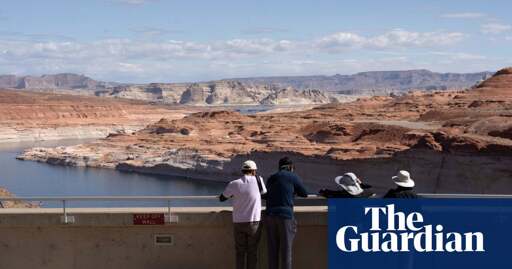- cross-posted to:
- [email protected]
- cross-posted to:
- [email protected]
Reservoir lost 27.8m acre-feet of groundwater in 20 years, Nasa study finds, vanishing ‘twice as fast as surface water’
The Colorado River basin has lost 27.8m acre-feet of groundwater in the past 20 years, an amount of water nearly equivalent to the full capacity of Lake Mead, the largest reservoir in the United States, a new study has found.
The research findings, based on Nasa satellite imagery from across the south-west, highlight the scale of the ongoing water crisis in the region, as both groundwater and surface water are being severely depleted.
“Groundwater is disappearing 2.4 times faster than the surface water,” said Jay Famiglietti, a hydrologist at Arizona State University and the study’s senior author.
“Everyone in the US should be worried about it, because we grow a lot of food in the Colorado River basin, and that’s food that’s used all over the entire country,” he added. “These days, we’re also supporting a number of data centers and computer chip manufacturers, and these are essential to our economy.”
STOP GROWING ALFALFA
“But I turned on the water…” St. Upid
Watching Katie Porter tearfully trying to get a continuence bill even to be voted on in committee regarding this issue was a bit heartbreaking.
Time to build out solar that does nothing but desalinate seawater. We’ve been overusing aquafiers for a very long time now and it simply has to stop.
There is no way that agriculture, industry and the like can be competitive with using desalinated sea water. The crazy water usage needs to stop. Nothing else will work.
Is your “no way” quantified with numbers or is it a gut feeling?
I did the math in a recent discussion and a square meter solar panel desalinates 60 cubic meters of seawater per year. Or, phrased differently, a square kilometer solar panel array supplies enough desalinated water for 60 square kilometers of crops.
https://livetoplant.com/the-cost-of-desalinated-water-is-it-worth-the-investment/
Typically, prices can range from $0.50 to $3.00 per cubic meter. As a comparison, traditional freshwater sources may cost significantly less—often between $0.10 and $0.50 per cubic meter in many regions.
So you run up the water costs by factor 5. But it only starts there. While the lower end of the basin is close to the Gulf of California, the upper end is some 800 miles away from the sea. Also the upper basin is at an elevation of about 1,500 m.
So for every cubic meter you get up there you need at least 4 kWh of energy purely to cover the elevation. more realistically you are looking at double that amount as you also need to cover the distance.
Furthermore you need to build the appropriate pipes and pumping stations. Those need to be kept up and manned, further driving the costs up.
So you end up with maybe $5-10 per cubic meter of water.
Think about the alternative though…
Farmers need to plant crops that are less water intensive. Industries need to use processes that are less water intensive. Water usage needs to be limited to sustainable levels.
Seem pretty reasonable and acceptable, even endorseable consequences as opposed to subsidizing wastefulness with megalomaniac technology projects.
Why not both?
Cost isn’t relevant - this is something we must choose to do as a society instead of emptying out the aquafiers.
If near-coastal water needs are solved using desalination you can keep a lot more water at higher elevations.
Cost is absolutely relevant. Resources are limited. As i have said the wasteful use by industry and agriculture needs to stop. I don’t understand why you are arguing against that and then claim that cost wouldn’t be relevant. Unless you want your taxes to be ramped up so some private business can waste subsidized water and make profits off it.
The solutions are reducing water usage by using more efficient processes or shutting down wasteful industries. Crops need to be switched to less water consuming crops. Meat consumption and animal farming need to be reduced. Natural structures that help retain water need to be reestablished. Fields need to be downsized with hedges in between to protect against winds eroding and drying out the soil.
These are the choices we need to make as society. Not throwing even more resources at a wasteful system that has no right to remain wasteful.
With enough energy resources aren’t limited. Solar is that energy, since for desalination we can perform it purely during daytime and won’t need to build out batteries etc as for other energy consuming industries.
I am sorry, but now it is getting ridiculous. You need solar panels. You need distribution lines. You need the desalination plants. If you run a reverse osmosis plant you need to regularly renew the membranes. You need the pipes and the pumps to transport the water for hundreds of kilometres. All of these need finite resources.
Claiming resources are unlimited is techbro nonsense.
Removed by mod
The problem with desalination is what do you do with the salt afterwards?
We have a shit ton of abandoned mines with a truly massive amount of space. Toss it in those.
The amount of freshwater used globally is tiny in comparison to the salt water in the oceans.
In case we desalinated the entire amount of consumed freshwater and dumped all the salt from that in the oceans, it would be impossible to even detect a rise in the oceans salt levels, provided that it was distributed properly and not just dumped in one location.
Water is also a cycle. It eventually returns to the ocean one way or the other after we’ve used it. With proper planning, we could theoretically borrow the water and mix the salt back in when it’s returned to the sea.
Dump it in a big pit in the nearest similar environment (sandy desert, bedrock etc). It’s all just weathered bedrock to begin with.
Could always throw in some cool salt sculpture activities for the kids in art classes as well (clearly we’d have to much salt haha) If there is an easy way to protect the salt from weathering, making giant salt sculpture museums would be pretty cool. Although they’d fall apart without protections.
That is 3.4 billion m³ of water. Imagine a cube of 1500m side length, all made of water.
Does this mean I should stop using fresh water for flushing my toilet?
Time to dismantle the Glen Canyon Dam.
I vote for dismantling data centers and computer chip manufacturers instead … because humans can survive without those.
We can’t without water.
I’d be willing to bet that growing alfalfa in the middle of the Arizona desert uses a lot more water than either of those industries.
And almonds. It’s something crazy like 5 times the water as a normal crop.
I found that out years ago and haven’t bought almond-anything since.
If you like water, you should agree then. Glen Canyon Dam causes tons of water loss through evaporation and to the porous sandstone below. Better to have that water stored in Lake Mead where it belongs.
Why?









